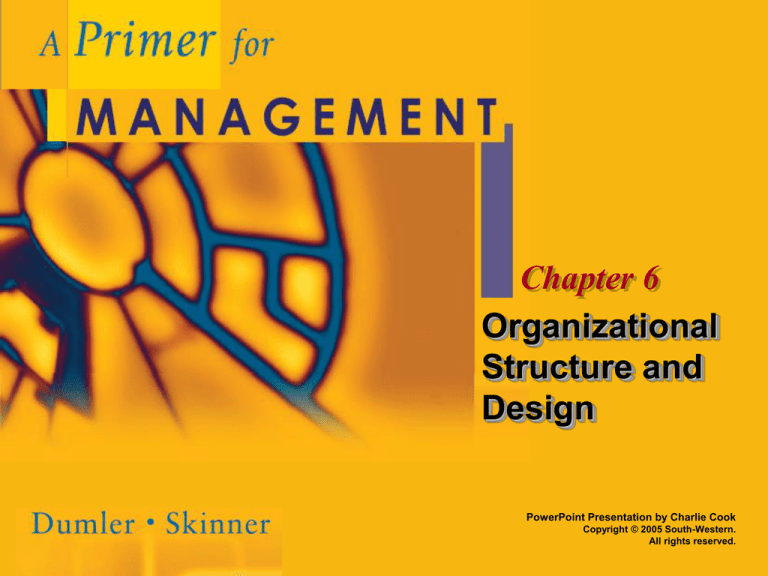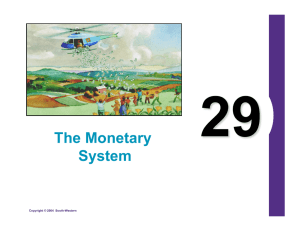
Chapter 6
Organizational
Structure and
Design
PowerPoint Presentation by Charlie Cook
Copyright © 2005 South-Western.
All rights reserved.
Organizing and Organizational Structure
• Organizing
The process of structuring both human and physical
resources to accomplish organizational objectives.
• Organizational structure
The framework of jobs and departments that directs
the behavior of individuals and groups toward
achieving the organization’s objectives.
Management’s responsibility is to develop a structure
that enhances the organization’s overall strategy.
Copyright © 2005 South-Western. All rights reserved.
6–2
Determining Organizational Structure
• The four major decisions:
Specialization of jobs
Delegation of authority
Departmentalization
Span of control
Copyright © 2005 South-Western. All rights reserved.
6–3
Determining Organizational Structure (cont’d)
Designing Organization Structure
Specialization of jobs
High
Low
Delegation of authority
Centralized
Decentralized
Departmentalization
Homogeneous
Heterogeneous
Span of control
Narrow
Wide
Exhibit 6 . 1
Copyright © 2005 South-Western. All rights reserved.
6–4
Determining Organizational Structure (cont’d)
Scientific Management versus Craftsmanship
Management Highlight
Copyright © 2005 South-Western. All rights reserved.
6–5
Determining Organizational Structure (cont’d)
• Teams and quality circles
Problem-solving team: knowledgeable workers who gather
to solve a specific problem and then disband.
Work team: a group of employees who work closely
together to pursue common objectives.
Self-managed work teams: workers who become their own
managers, which increases reliance on their creative and
intellectual capabilities besides their labor.
Quality circle: a group of fewer than ten workers who do
similar work and meet weekly to discuss their work,
identify problems, and present possible solutions.
Copyright © 2005 South-Western. All rights reserved.
6–6
Determining Organizational Structure (cont’d)
• Delegation of authority
Decentralization: the process of distributing authority
throughout the organization.
Centralization: the process of retaining authority in the
hands of high-level managers, who make all the
decisions.
Empowerment: giving employees who are
responsible for hands-on production or service
activities the authority to make decisions or take
action without prior approval.
Copyright © 2005 South-Western. All rights reserved.
6–7
Determining Organizational Structure (cont’d)
• Delegation of authority (cont’d)
Chain of command
Delegation
of authority creates a formal channel that
defines the lines of authority from the top to the bottom
of an organization.
Line position: a position in the direct chain of
command that contributes directly to achieving the
organization’s goals.
Staff position: a position not in the direct chain of
command that facilitates or provides advice to line
positions.
Copyright © 2005 South-Western. All rights reserved.
6–8
Determining Organizational Structure (cont’d)
Chain of Command
Exhibit 6 . 2
Copyright © 2005 South-Western. All rights reserved.
6–9
Determining Organizational Structure (cont’d)
Differentiating between Line and Staff Positions
Line position ———
Staff position --------
Exhibit 6 . 3
Copyright © 2005 South-Western. All rights reserved.
6–10
Determining Organizational Structure (cont’d)
• Departmentalization
The process of grouping jobs according to some
logical arrangement.
As organizations grow in size and job specialization
increases, it becomes necessary to determine how to
best to arrange and group jobs.
• Common bases for departmentalization
Functional
Product
Customer
Copyright © 2005 South-Western. All rights reserved.
Geographic
Mixed
Matrix organization
6–11
Determining Organizational Structure (cont’d)
Functional Departmentalization
Exhibit 6 . 4
Copyright © 2005 South-Western. All rights reserved.
6–12
Determining Organizational Structure (cont’d)
Product Departmentalization
Exhibit 6 . 5
Copyright © 2005 South-Western. All rights reserved.
6–13
Determining Organizational Structure (cont’d)
Customer Departmentalization
Exhibit 6 . 6
Copyright © 2005 South-Western. All rights reserved.
6–14
Determining Organizational Structure (cont’d)
Geographic Departmentalization
Exhibit 6 . 7
Copyright © 2005 South-Western. All rights reserved.
6–15
Determining Organizational Structure (cont’d)
Mixed
Departmentalization
Exhibit 6 . 8
Copyright © 2005 South-Western. All rights reserved.
6–16
Determining Organizational Structure (cont’d)
Matrix Organization
Exhibit 6 . 9
Copyright © 2005 South-Western. All rights reserved.
6–17
Determining Organizational Structure (cont’d)
Wide versus Narrow Span of Control
A. Wide Span of Control
B. Narrow Span of Control
Exhibit 6 . 10
Copyright © 2005 South-Western. All rights reserved.
6–18
Determining Organizational Structure (cont’d)
• Factors to consider in determining span of
control
Competence of both the manager and the
subordinates.
Degree of interaction required among the units to be
supervised.
Extent to which the manager must carry out
nonmanagerial tasks.
Relative similarity or dissimilarity of the jobs being
supervised.
Extent of standardized procedures.
Degree of physical dispersion of subordinates.
Copyright © 2005 South-Western. All rights reserved.
6–19
Dimensions of Organizational Structure
• Formalization
The extent to which organizational communications
and procedures are written down and filed.
• Centralization
How much the authority to make decisions is
dispersed throughout the organization.
• Complexity
The number of different job titles and the number of
different departments in an organization.
Copyright © 2005 South-Western. All rights reserved.
6–20
Organizational Design
• Organizational design
The process by which managers develop an
organizational structure.
• Issues affecting organizational design
Specialization of jobs
Centralization and delegation of authority
Departmentalization
Span of control
• Models of organization design
Mechanistic model
Organic model
Copyright © 2005 South-Western. All rights reserved.
6–21
Organizational Design (cont’d)
• Mechanistic model
Mechanistic organization: a rigid organization that
attempts to achieve production and efficiency through
rules, specialized jobs, and centralized authority.
Max Weber’s bureaucracy: an organization based on
a formal system of legitimate authority.
Copyright © 2005 South-Western. All rights reserved.
6–22
Organizational Design (cont’d)
• Characteristics of a bureaucracy
Tasks are divided into highly specialized jobs.
Each task is performed according to a standardized
set of rules that ensures uniformity.
Each member of the organization is accountable to a
single manager.
Business is conducted impersonally, and managers
maintain a social distance from workers.
Employment and advancement are based on merit
and technical qualifications, and workers are
protected from arbitrary dismissal.
Copyright © 2005 South-Western. All rights reserved.
6–23
Organizational Design (cont’d)
• Organic model
Organic organization: an organization that is
decentralized with communication flows throughout
the organization rather than through the chain of
command.
Seeks
to maximize flexibility and adaptability.
Encourages
greater utilization of human potential.
Deemphasizes
specialization of jobs, status, and rank
to encourage horizontal and lateral relationships.
Provides
individuals with a supportive work environment
and builds a sense of personal worth and importance.
Copyright © 2005 South-Western. All rights reserved.
6–24
Organizational Design (cont’d)
• Contingency approach
Designing an organization to effectively function in the
face of the unique contingencies or circumstances of
its competitive environment.
Contingencies that influence this decision include:
Technology
used to produce good or service
Environmental stability or instability
Strategy chosen
Copyright © 2005 South-Western. All rights reserved.
6–25
Organizational Design (cont’d)
• Contingencies affecting design
Technology
Routine
technologies = mechanistic organization
Nonroutine technologies = organic organization
Environment
Stable
environment = mechanistic organization
Unstable environment = organic organization
Strategy
Structure
follows strategy
Single product/market = organic structure
Diversification = mechanistic structure
Copyright © 2005 South-Western. All rights reserved.
6–26
Other Forms of Organizational Design
• Multidivisional organization
A high-performance organization whose operating
units or divisions are partially interdependent.
Each division is different, but all divisions share
common technology, skill, and information.
• Network organization
A flexible, temporary relationship between
manufacturers, buyers, suppliers, and customers.
The design is dynamic in that the major components
can be assembled or reassembled to meet changing
competitive conditions.
Copyright © 2005 South-Western. All rights reserved.
6–27
Other Forms of Design (cont’d)
• Network organization (cont’d)
Virtual corporation
A temporary
series of partnerships of organizations,
linked by information technology, that come together
quickly to exploit fast-changing opportunities and
terminate once an opportunity is met.
Modular corporation
A hub
surrounded by a network of the best suppliers in
the world.
The hub is the center of activities, such as research and
development; the network is made up of outside
specialists.
Copyright © 2005 South-Western. All rights reserved.
6–28




